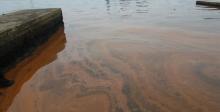Plankton
Benjamin Button Effect: This sea creature turns back time
All living things are born, grow, grow old and die. All? For a few, it turns out, aging is not a one-way street, as they can revert to their early form.
Excessive phytoplankton concentration turns Thessaloniki sea green
The sea in the northern port city of Thessaloniki turned green on Tuesday, due to excessive concentration of phytoplankton in the area.
Zakynthos: Tsilivi Beach Filled with Foam – Professor Explains the Phenomenon
Satellite photos show increased phytoplankton production in the Ionian Sea
Sea snot absent from Istanbul’s shores
Large globules of mucilage which had been sighted since March in the Sea of Marmara offshore Turkey's largest city of Istanbul are now absent.
class='cf'>
Work initiated by Turkey's Environment and Urbanization Ministry to combat mucilage, also known as sea snot, has yielded significant results.
- Read more about Sea snot absent from Istanbul’s shores
- Log in to post comments
Bosphorus waters to remain turquoise-tinged until the end of June
The waters of Istanbul's Bosphorus Strait will retain their turquoise color, caused by phytoplankton, until the end of June, Professor Bayram Öztürk from Istanbul University has stated.
Öztürk, from the university's aquaculture department, said the phytoplankton will remain prominent until the end of the month under current weather conditions.
Dolphins photographed swimming in turquoise-colored Bosphorus waters
A school of dolphins was photographed on June 18 swimming at Istanbul's Bosphorus Strait, which has recently been offering a feast for local eyes after its waters turned turquoise due to phytoplankton.
Black Sea, Bosphorus turns turquoise due to phytoplankton: Report
A significant part of the Black Sea has turned turquoise due to phytoplankton, a new picture from space shared by NASA showed June 12.
The Moderate Resolution Imaging Spectroradiometer (MODIS) on NASA's Aqua satellite first captured the phytoplankton bloom in the Black Sea on May 29.
Thessaloniki port turns red (photos)
The citizens of Thessaloniki strolling along the port of Thermaikos were in for a surprise, as the waters had turned red. The natural phenomenon, which is known as the “red tide”, is created from a rapid development of uni-cellar photosynthetic plankton organisms. It is phenomenon that appears on a regular basis in Thessaloniki, which results in reddish spots on the water surface.
- Read more about Thessaloniki port turns red (photos)
- Log in to post comments
Stunning! View Nasa’s animated map that breathes like the earth
The video below reveals the 12-month life cycle of the world’s plant life. Pulsating masses of color represent fluctuations of density of plant growth on land and chlorophyll concentration from phytoplankton in the oceans. Density of land vegetation on the map ranges from barren brown to rich green where plant life is the most luscious.







